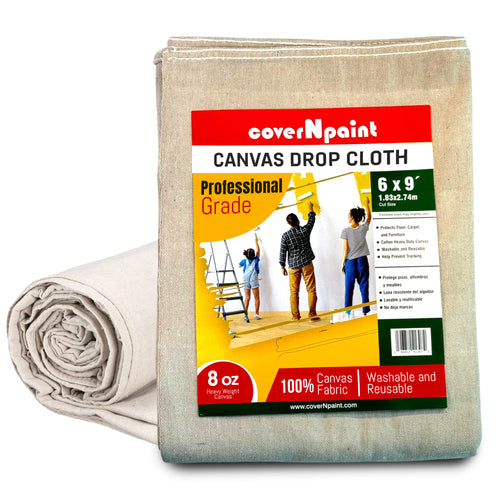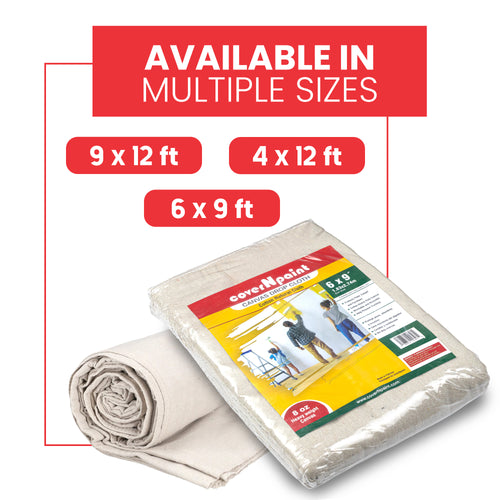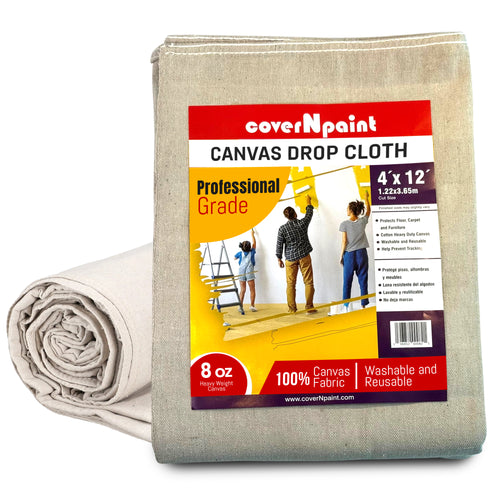Painting a wood floor can significantly improve the way your room feels and looks. To safeguard the surrounding spaces and ensure a neat and polished finish, Drop Cloths must be used. We'll walk you through how to utilize paint protector efficiently in this article so that your wood floor painting process goes smoothly and without any problems.
What is a Drop Cloth?
A painting sheet is a protective covering used during painting or construction projects to shield floors, furniture, and other surfaces from paint spills, dust, and debris. Made from various materials such as canvas, plastic, or paper, protection sheet are essential for maintaining cleanliness and preventing damage.
Why Use a Drop Cloth for Wood Floor Painting?
Using a painter’s tarp when painting a wood floor is crucial for several reasons:
· Protection:
Prevents paint splatters from staining the floor and surrounding areas.
· Safety:
Reduces the risk of slipping on wet paint.
· Efficiency:
Makes cleanup easier and faster.
Types of Drop Cloths
Selecting the appropriate paint spill protection depends on your specific needs. Here are the most common types:
Canvas Drop Cloths:
Durable and reusable, canvas protective sheet provides excellent protection and absorbency. They are ideal for heavy-duty painting projects.
Plastic Drop Cloths:
Lightweight and inexpensive, plastic surface cover are waterproof and disposable. They are suitable for light-duty projects.
Paper Drop Cloths:
Paper painting supplies are a cost-effective option for single-use projects. They are less durable than canvas but still provide adequate protection for short-term use.
Factors to Consider
When choosing a protective sheet, consider the following factors:
Size:
Ensure the heavy-duty cloth is large enough to cover the entire work area.
Material:
Choose a material that suits the nature and scale of your project.
Thickness:
Thicker paint splatter guard offer better protection but may be heavier and more cumbersome to handle.

Preparing Your Space
Clearing the Area
Before you begin painting, clear the area of furniture, rugs, and other items. This will give you ample space to work and ensure that nothing gets accidentally damaged.
Cleaning the Floor
Thoroughly clean the wood floor to remove any dust, dirt, or debris. A clean surface helps the paint adhere better and ensures a smoother finish.
Laying Down the Drop Cloth
Positioning the Canvas Cloth
Unfold the floor protector and lay it flat over the wood floor. Ensure that it covers the entire area you will be painting, as well as any adjacent surfaces that need protection.
Securing the Drop Cloth
To prevent the waterproof tarp from shifting while you work, secure it in place. Use painter’s tape or masking tape to fasten the edges of the dust sheet to the floor. For added stability, you can also use weights or heavy objects to hold down the corners.
Painting the Wood Floor
Before you start painting, gather all the necessary supplies:
- Paint and primer
- Paint rollers and brushes
- Paint tray
- Stir sticks
- Painter’s tape
Applying Primer
Start by applying a primer to the wood floor. Primer helps the paint adhere better and ensures a more even finish. Use a paint roller for larger areas and a brush for edges and corners. Allow the primer to dry completely before proceeding.
Painting the Floor
Once the primer is dry, you can begin painting the floor. Follow these steps for the best results:
Stir the Paint: Thoroughly stir the paint to ensure it is well-mixed.
Pour the Paint: Pour a small amount of paint into a paint tray.
Roll the Paint: Use a paint roller to apply the paint in even strokes, starting at one corner and working your way across the room.
Cut in Edges: Use a brush to carefully paint the edges and corners where the roller cannot reach.
Allow to Dry: Let the first coat dry completely before applying additional coats. Multiple coats may be necessary for full coverage.
Cleanup and Final Touches
Removing the Drop Cloth
Once the paint is completely dry, carefully remove the paint drip protection. Fold it inward to contain any paint splatters and prevent them from spreading to other areas.
Inspecting the Floor
Inspect the painted floor for any missed spots or imperfections. Touch up as needed to achieve a flawless finish.
Cleaning Up
Clean your painting supplies thoroughly to maintain their longevity. Dispose of any disposable drop cloths and properly store reusable ones for future projects.
Tips for Success
Working in Sections
Painting large areas can be overwhelming. Divide the floor into manageable sections and complete one section at a time. This approach ensures that you maintain control and achieve a consistent finish.
Ventilation
Ensure the room is well-ventilated while painting. Proper ventilation helps the paint dry faster and reduces the risk of inhaling fumes.
Using Quality Materials
Investing in high-quality paint, primer, and drop cloths can make a significant difference in the outcome of your project. Quality materials provide better coverage, durability, and protection.
Most Reliable Supplier of Drop Cloth in USA
CoverNpaint is the leading source for premium canvas drop cloths in the USA. Canvas multi-purpose tarp are well-known for their strength and remarkable absorbency, making them perfect for demanding painting jobs. Since their products are constructed from premium materials, they offer the best defense against paint splatters and spills. With the range of sizes that CoverNpaint provides to accommodate various project requirements, finding the ideal match for your area is simple.
Choosing the Right Drop Cloth
Selecting the appropriate absorbent cloth depends on your specific needs. Here are the most common types:
Canvas Drop Cloths:
Durable and reusable, canvas cloths provide excellent protection and absorbency. They are ideal for heavy-duty painting projects.
Plastic Drop Cloths:
Lightweight and inexpensive, plastic slip-resistant cloth are waterproof and disposable. They are suitable for light-duty projects.
Paper Drop Cloths:
Paper paint masking is a cost-effective option for single-use projects. They are less durable than canvas but still provide adequate protection for short-term use.
Painting a wood floor can completely change the appearance of your room, but for a professional finish, careful planning and protection are needed. It is imperative to use a drop cloth to safeguard your flooring and maintain a hygienic and secure workplace. You may confidently finish your project by priming your area, selecting the ideal paint barrier, and using the right painting procedures.













